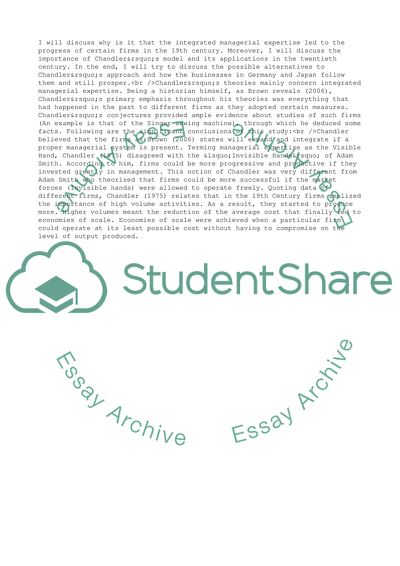Cite this document
(Chandlers Model of Integrated Managerial Enterprise Essay - 1, n.d.)
Chandlers Model of Integrated Managerial Enterprise Essay - 1. https://studentshare.org/business/1734923-to-what-extent-do-you-accept-chandlers-claim-that-his-model-of-the-integrated-managerial-enterprise-uncovers-the-long-term-success-of-leading-economies-can-this-organizational-form-be-applied-across-varied-national-circumstances
Chandlers Model of Integrated Managerial Enterprise Essay - 1. https://studentshare.org/business/1734923-to-what-extent-do-you-accept-chandlers-claim-that-his-model-of-the-integrated-managerial-enterprise-uncovers-the-long-term-success-of-leading-economies-can-this-organizational-form-be-applied-across-varied-national-circumstances
(Chandlers Model of Integrated Managerial Enterprise Essay - 1)
Chandlers Model of Integrated Managerial Enterprise Essay - 1. https://studentshare.org/business/1734923-to-what-extent-do-you-accept-chandlers-claim-that-his-model-of-the-integrated-managerial-enterprise-uncovers-the-long-term-success-of-leading-economies-can-this-organizational-form-be-applied-across-varied-national-circumstances.
Chandlers Model of Integrated Managerial Enterprise Essay - 1. https://studentshare.org/business/1734923-to-what-extent-do-you-accept-chandlers-claim-that-his-model-of-the-integrated-managerial-enterprise-uncovers-the-long-term-success-of-leading-economies-can-this-organizational-form-be-applied-across-varied-national-circumstances.
“Chandlers Model of Integrated Managerial Enterprise Essay - 1”. https://studentshare.org/business/1734923-to-what-extent-do-you-accept-chandlers-claim-that-his-model-of-the-integrated-managerial-enterprise-uncovers-the-long-term-success-of-leading-economies-can-this-organizational-form-be-applied-across-varied-national-circumstances.


